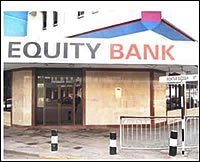Mainstream Banks Besiege Microfinance Sector

 |
| Equity Bank: Spreading its wings countrywide |
The “open new branch” obsession is informed by “the catch-up” strategy, enactment of the microfinance bill and the business realities of our times. Globally, research suggests that working with the economically active low income persons and giving them a hand as they fight their poverty, is profitable. The strategy is confirmed by Compartamos (albeit pricing issues) Bank in Mexico and our very own Equity Bank. Equity bank, has within a short time joined the big boys or the “ billion club” of banking in Kenya with its unique downscaling business model that caters for the low end, making money with them and from them.
Granted these expansion strategies favour consumers through affordable pricing and innovative products and services, the microfinance industry is set to bear the brunt. Many analysts are wondering whether the microfinance industry will survive for “donkey years” onslaught. This has further been complicated by the post election violence that hit them most.
The Microfinance sector in Kenya has had an impressive growth. Every small trading centre in Kenya has at least some financial services provider, thanks to this innovation. Microfinance is about providing small loans for working capital through use of collateral substitutes to low income entrepreneurs in viable economic activities. The tragedy for microfinance is that its business model is expensive. The low income access small loans and require frequent monitoring thereby excerbating the institution costs leading to high interest rates that sometimes overprices institutions out of the market.
While microfinance has been a force for good in reducing poverty, the dynamics in the financial services sector point to an industry under siege. The onslaught by banks goes beyond opening of new branches. It is no secret that the the microfinance sector is literally subsidising bank operations in Kenya. This is evidenced by the high staff turnover in microfinance institutions at lending officers level. Microfinance institutions have been reduced to recruitment agents and “training institutes” for the local banks. It is expensive to recruit lending staff in Kenya.
For microfinance institutions to ensure their staff can deliver quality in the field, they invest in staff training. It takes a minimum of three months to effectively train a loan officer and subsequently manage a portfolio. After a short stint, the lending officers join the banks. No wonder, industry commentators believe the current bank growth and drive may be on the back of other players other than bank managers' business prowess. The effect is, microfinance institutions are on hiring mode 24/7, coupled with portfolio exposure and disruptions to their business plans. All this increases the cost of doing business for these institutions. Its no longer business as usual. Further, mainstream banks are setting shops where these institutions have operated for years.
Microfinance institutions have been lagards on innovation and rigid in product offerings. Rational successful entrepreneurs tired of weekly, fortnight or monthly meetings propagated by microfinance institutions self-graduate and pitch camp in the banks. It is still prestigious for the unbanked to be a customer of a local bank in Kenya. This comes with status, convinience and other embedded services that microfinance institutions can’t and won't provide.
Research shows that microfinance institutions start to make money from a customer sometimes after the third or fourth loan. Client desertion at that level or before to join any of the banks shall end up subsiding the bank further. The banks get new clients with a credit history. All this while, bankers know that good loans do not just happen, it’s a process- not an event. The cost to the banker drops drastically in making the new loan. A case of reaping where you’ve not sowed.
The plausible strategic response by microfinance institutions to competition by banks would be mergers and partnerships. For survival, there will be mergers among microfinance institutions, buyout by banks and partnerships with foreign social investors. Some microfinance institutions will get specialised and deliver value; serve up-market and remain blind to their mission or serve down market and charge a little more. Microfinance institutions will be forced to reach the marginal client. MFIs that remain in the urban areas will be forced to review their charges to reflect the onslaught from banks.
Fortunately, the microfinance industry had seen this coming hence the microfinance bill. Most microfinance institutions are in the process of transforming to regulated deposit taking financial intermediaries with profound change in product offerings, governance and management structures. Transforming will help these institutions to offer additional products and services such as savings and gain access to capital either through debt or equity. The microfinance institutions that will go through this process successfully may as well see light at the end of the tunnel.
The conundrum between banks and microfinance mimics at its best the african jungle. In the morning, the antelope and the lion wake up and thank their maker for a new day. But while the antelope spends the whole day running from the lion, the lion spends the whole day looking for the antelope. This analogy could explain the business wars on market share in the financial services sector in Kenya. The best will survive and the laggards will take a walk. It couldn’t have been better for the consumer!
Charles G. Njoroge
BDS consultant and Microfinance Trainer
cgnjoro@gmail.com
